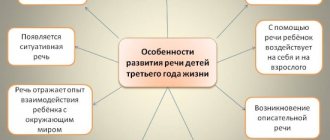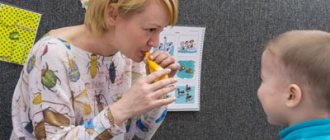Most often, speech disorders are detected at the age of 3 years, when the child begins to actively speak. Using a real example, we tell you what general speech underdevelopment (GSD) is in children, whether it is a dangerous diagnosis or not, and how you can help your child speak at home.
⠀
Speech development disorders can occur in children raised in ordinary families, and in children from bilingual families, i.e. in congenital bilinguals, when the child’s parents speak different languages.
⠀
Young bilingual children learn two languages from early childhood - the first, the main language, and the second, which is spoken less often. Therefore, speech problems in such children are most often associated with incorrect pronunciation of sounds and mixing of languages in speech.
⠀
From this article you will learn:
- what is general speech underdevelopment (GSD) in children;
- Is this diagnosis dangerous or not?
- in what cases should you sound the alarm;
- what specialists to contact;
- How can you help your child speak at home?
⠀
To make it clearer for you, we will analyze all the questions using a real example.
What is general speech underdevelopment (GSD) in children?
General speech underdevelopment (GSD) is a violation of the development of speech skills in a child. Most often, it can be detected at the age of three, when the child begins to actively talk. But OHP is not a symptom of a serious illness, but most often simply insufficient attention of parents to the child’s speech. For example, if a child says “yba”, “suba”, “dau”, and the parents do not correct him, thinking that “it will go away on its own”.
⠀
Four months ago, one of the social networks of the Kidskey online school received the following message:
⠀
“My son is 4 years old. He has been going to kindergarten since he was 3 years old, but he hardly speaks. His speech is similar to the babble of a one-year-old child. I understand it only when it is explained by gestures. My friends reassure me that boys start talking later, but I am very worried because in the kindergarten the children do not want to play with my son, he constantly cries, gets angry and even offends his classmates.
⠀
I do not know what to do. Please tell me, should I do something now or should I wait until the child outgrows it? Is it necessary to go to a specialist or can you practice speech development at home?”
⠀
It is difficult to give some abstract advice without talking to the child. That's why we invited the mother and boy for a free online consultation.
⠀
Wonderful and smiling Roma had no problems with hearing or intelligence, but he communicated with our methodologist like this:
⠀
- instead of “give” he said “yes-yes”, instead of “there is” he said “us-us”;
- instead of a whole word, he named only the root and used it to designate several words at once - “ma” - “machine”, “ba” - “drum”, “banana”, “battery”;
- he spoke the same words in different ways: “machine” - “asha”, “bibi”, “pipi”, “si”;
- I shortened complex words and phrases: “mom went to work” - “ma sya a atu.”
⠀
After the consultation, it became clear that Roma has general speech underdevelopment (GSD) of the first degree.
Speech therapists can make this diagnosis to a child if he said his first words only after 3 years or if he explains himself more with gestures. For example, instead of saying “Mom, give me some candy,” he says “give me,” and then points his finger at the cabinet where the sweets are.
⠀
Below is a table with the norms for child speech development by age . Take a look, but don’t get too hung up on this data - each child is individual and develops at his own speed.
How to determine speech delay
Speech defects for 4-year-old children can be varied: the child may not utter a sound or, on the contrary, speak a lot, but is completely unintelligible. Both cases at this age should be a reason for parents to contact a number of specialists, namely: a neurologist, psychoneurologist, defectologist, speech therapist or otolaryngologist.
The main signs by which speech development delay can be easily determined are:
- the child speaks in such a way that it is sometimes difficult or even impossible to understand the meaning of sentences or even individual words;
- the baby has no interest in communicating, even with the closest people;
- vocabulary is very limited (in some cases even 20 words);
- the child does not express a desire to repeat the parents’ words or silently withdraws during such activities;
- the baby does not perceive and does not fulfill requests that contain two actions, for example, take a toy and put it on the sofa;
- the child understands everything and fulfills basic requests, but never comments on the process;
- When pronouncing sentences, most words are lost.
Speech development disorders directly affect the child’s character and behavior; he withdraws into himself, is often capricious, cannot and does not want to sit in one place, and does not show any interest in communicating with peers.
When to sound the alarm if a child does not speak?
- If up to 8-9 months of life the baby is more silent.
- If a year does not respond when you talk to him. For example, if you ask “where is the chair?”, and he does not turn his head towards where the chair is. And to attract your attention, he often cries.
- If at 1.2 - 1.6 years the child does not distinguish familiar objects by ear and cannot show them in the picture. For example, you ask him to show where the bed is, but he cannot show it either in the room or in the picture.
- If at 1.5 - 2 years old the child does not understand how to fulfill your simplest requests. For example: “Give me a cup from the table,” “Take the little soldier and put him in the box.”
- If at 2–3 years old the child does not speak simple sentences. For example: “Mom, I want to eat”, “Dad, here.”
- If at 3–4 years old a child cannot speak in sentences. For example: “Dad came home from work,” “The dog is lying under the table.” He also pronounces most sounds incorrectly.
Speech disorders according to ICD-10
In the International Classification of Diseases, specific speech development disorders are coded F80, R47, F84, F98. These include the following pathologies:
- receptive speech disorder – the child does not understand what is being said to him;
- expressive language disorder - he cannot speak in accordance with his age;
- speech articulation disorder – makes sounds inappropriate for age (1-2 years);
- dysphasia, aphasia – damage to the cerebral cortex, in which speech is impaired or absent;
- dysarthria, anarthria - speech disorders as a result of problems in the innervation of the articulatory apparatus, pathologies of the nervous system;
- autism;
- stuttering and other pathologies.
Is OHP of the first degree dangerous?
OHP itself is not dangerous, but if correction is not started in time, the consequences can be serious. Speech therapists and neurologists say that up to 3 years of age there is no need to worry. But if your child is already 3 years old and does not speak at all or only said his first word at this age, this may be a signal of delayed speech development.
⠀
If you continue to ignore the problem, it will get worse. Against the background of underdevelopment of speech, mental development may be disrupted: thinking will become inhibited, concentration and memory will deteriorate, and coordination of movements will be impaired.
⠀
The child’s performance at school will drop, self-esteem will decrease and complexes will appear, he will become withdrawn and prone to depression. To prevent this from happening, it is advisable to identify the problem as early as possible and take action.
Slurred speech or erased dysarthria? Speech therapist advice
It happens that parents and teachers scold the child for inattention, reduce grades for missing letters and for vague answers in class. But the problem is not laziness or inattention, but functional disorders of the nervous system. Doctor of Pedagogical Sciences, professor, speech therapist Elena Arkhipova spoke about erased dysarthria - unintelligibility of speech caused by organic reasons - on the online platform of the Institute of Additional Vocational Education for Social Workers.
Dysarthria is not a purely childhood problem; speech impairment can also occur in adults. And in this case, the help of a speech therapist is also necessary. Let's figure out what dysarthria is, what its causes are and how to work with it.
The exact definition will sound like this: dysarthria is a violation of sound pronunciation and prosody due to a violation of the innervation of the muscles of the speech apparatus. And two more unfamiliar words at once! We'll figure it out further
Prosody is the intonation expressiveness of speech. It is expressed in the rate of speech, voice modulations, intonation, logical stress, etc.
Innervation is a neurological term meaning the conduction of nerve impulses from the brain to the muscles.
It turns out that dysarthria has organic causes, that is, it is associated with disorders in the development of the nervous system. This means that work with her must begin not at the speech therapy level, but at the neurological level. Actually, dysarthria is only a symptom signaling damage to the nervous system.
Causes of dysarthria in children:
- intrauterine pathology;
- birth injuries;
- Rh conflict between child and mother;
- traumatic brain injuries, etc.
Causes of dysarthria in adults:
- cerebrovascular accident;
- traumatic brain injury;
- brain tumors.
Where does work with disarty begin?
The first stage is medical. It is performed by a neurologist. In the arsenal of doctors - the necessary medications, physiotherapy, therapeutic massage, reflexology, in short, means aimed at strengthening the central nervous system and eliminating pathological symptoms.
The second stage is psychological and pedagogical. A whole team of specialists participates in it: educators, defectologists, psychologists, speech therapists. It is important to involve parents too. The goal of this stage is the development of sensory functions, spatial representations, gross motor skills, and fine motor skills.
The third stage is the actual speech therapy stage. A speech therapist eliminates dysarthria in individual sessions.
Erased dysarthria is the most common disorder in preschoolers and primary schoolchildren. Unfortunately, the diagnosis is not always made. Parents and teachers scold the child for inattention, lower grades for missing letters and for unclear answers in class. But it often turns out that the student diligently completes homework, learns the rules and does not make grammatical errors, but misses letters in writing and speaks in monosyllables. His problem is not laziness or inattention, but functional disorders of the central nervous system. And he cannot cope with this with a simple effort of will.
Before starting work with such a child, the speech therapist needs to carefully understand the causes of the problem, and only then choose correction methods.
Tests to identify erased dysarthria.
- For static coordination of movements. Ask your child to stand on one leg for a few seconds. Then to another.
- For dynamic coordination of movements. You need to hit the target with a small ball. For example, into another ball.
- Another dynamic task: jump over a stretched elastic band.
- To study the speed of movements. The child should, at your command, sit on the floor and stand up without using his hands.
- For motor memory. Repeat the series of simple movements shown by you in exactly the sequence and at the speed that you specified.
- For simultaneity of movements. Wind the thread onto the spool while walking in place.
Research shows that children with erased dysarthria have deviations from the standards for all these indicators.
Please note that these tests are not aimed at diagnosing speech development, but at motor skills. The fact is that the development of psychomotor skills is significantly ahead of the development of speech and thinking. Motor development is the basis for the formation of higher mental functions. That is why correctional work with dysarthria begins with the formation of motor skills - general, manual, finger, facial. There is a whole range of exercises to help specialists: finger games, a “magic bag”, performing familiar everyday activities with eyes closed, origami, appliqué, adaptive physical education and much more. The main thing is to remember: the sooner you identify and start working with erased dysarthria, the fewer difficulties the child will have at school, and then in adult life. After all, illegible speech greatly complicates communication, and sometimes even interferes with the choice of profession.
Watch even more webinars from the Institute of Additional Vocational Education on the “I’m at home” portal in the “Online workshops” section
Press service of the Department of Labor and Social Protection of the Population of Moscow
Who should you contact to identify general underdevelopment?
If a child does not speak at 4 years old, it is better to show him to several specialists at once:
⠀
- speech therapist-defectologist - will assess the severity of the speech disorder and suggest the direction of correctional work;
- ENT specialist - will help make sure that hearing is normal;
- a neurologist - will examine the child, get acquainted with the baby’s development chart to exclude organic damage and, if necessary, prescribe appropriate medications.
⠀
Often, a consultation with an experienced speech pathologist-speech pathologist is enough to determine ODD and begin correction, as in the case of our student Roma.
⠀
But if the speech therapist still recommends visiting other specialists, then you should listen.
Diagnosis by a speech therapist and other specialists
If you suspect a delay in speech and mental development, it is important not to waste time, but to immediately contact a speech therapist. Sometimes, in addition to this specialist, consultations with a psychologist, psychoneurologist, neurologist, or defectologist are required. The specialist conducts differential diagnostics using special methods and tools to determine the exact cause of the underdevelopment of means of communication. Hearing, the integrity of mental processes, articulation, and physiological abnormalities in the speech apparatus are checked.
It is not for nothing that a routine examination by a speech therapist is required at 3 years of age. This is the most favorable age for the most effective correction of speech problems.
The doctor prescribes treatment aimed at restoring the nervous system, hearing, vocal cords and other organs if there is a problem with them. At 3 years old it is still possible to “catch up” with the missed stages of speech development, but then it is more difficult to do this.
What to do if a child is diagnosed with first degree ODD?
We gave Romina’s mother 10 basic recommendations on how to develop a child’s speech at home. The first four relate to communication, and the next six work on speech development:
Watch your speech
Don’t babysit with your child, pronounce words, phrases, and sentences clearly. Watch your pace - don't speak too fast and not too slow. Children always follow the example of their parents.
Don't use difficult words when talking to your child
Phrases should be simple and understandable. If, for example, you are reading a book where you come across unfamiliar words, stop and explain the meaning to your child.
Ask simple, specific questions and don’t rush into answers.
For example: “Are you cold?”, “Do you want to eat?”, “Does anything hurt?” etc. It will be easier for the child to answer clear questions.
Don’t scold for speech errors, but correct them gently
For example, a child said “paishou”, and you carefully said to him: “Bunny, he went to speak correctly.”
If there are other people around at this moment, say so that no one can hear you. Then the child will not be embarrassed.
Develop fine motor skills of your hands
Allow your child to dress and tie his own shoelaces; often let him sculpt, paint, draw, assemble mosaics and construction sets. The better the motor skills of a child’s hands are developed, the better the brain works, and the faster speech normalizes.
Do breathing exercises with your child
The child will be able to speak clearly, for a long time, without stuttering or stuttering.
Develop phonemic awareness
Phonemic hearing helps the rapid and correct development of oral speech through the ability to hear and distinguish sounds. Find examples of games and simple exercises on how to develop phonemic awareness here.
Do articulation exercises
Such gymnastics is aimed at training everything that helps us speak: the muscles of the face and mouth, nose and voice. A developed articulatory apparatus will help the child immediately pronounce sounds correctly.
⠀
This includes exercises such as “pipe duck”, “fence”, “horse”, tongue massage with a toothbrush, etc. You can easily find all these exercises on YouTube.
Control how much time your child spends on gadgets
The child should spend more time in outdoor games. For example, at home you can also jump, play tag, and build a house out of chairs, pillows and blankets.
Symptoms and treatment
The main symptoms include the following:
- incomprehensible, slurred speech;
- spastic manifestations in the articulatory muscles (neck, lips, face, tongue are constantly tense, articulation is limited, lips are tightly closed);
- hypotonia of the articulatory apparatus (lips do not close, tongue lies motionless in the mouth, mouth is slightly open, increased salivation);
- dystonia of articulatory muscles (when a child tries to talk, his muscle tone goes from low to high);
- slurred pronunciation;
- in difficult cases, the child misses sounds, replaces them or pronounces them distorted; Source: O.Yu. Fedosova Features of sound pronunciation of children with mild dysarthria // Speech therapist in kindergarten, 2005, No. 2, pp. 36-41
- slowness of conversation;
- inability to speak (in severe forms);
- nasal voice without signs of a runny nose;
- change, omission, replacement of some sounds with others;
- fading of a phrase towards the end of its utterance, rapid breathing during a conversation due to lack of air;
- very high, almost “squeaky” voice;
- a fast or very slow flow of words, while the child cannot change the tone.










